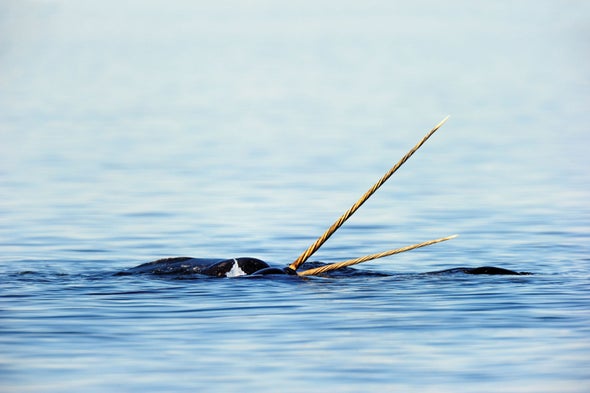Narwhal tusks record decades of environmental information and clearly show a changing Arctic, researchers reported in Current Biology. Every year the spiraling tusks grow another layer, incorporating variants of carbon and nitrogen called isotopes and some of the mercury a narwhal consumes. The researchers bought 10 tusks from Inuit subsistence hunters in northwestern Greenland and found that the objects contained nearly 50 years' worth of information.
Having access to such a long stretch of data “was just an amazing step forward in our understanding of the factors that affect things like diet and mercury [levels],” says lead author and McGill University marine biologist Jean-Pierre Desforges.
The researchers sliced open the whale tusks (which are actually teeth, made of dentine), ground parts of them into powder and analyzed the samples' isotope content. The results indicate where and what a narwhal might have eaten, as well as its exposure to mercury—a potent toxin whose accumulation affects animals' immune and reproductive systems.
From the 1960s to the 1990s, when sea ice covered much of the narwhals' habitat, carbon and nitrogen isotopes suggest that the animals ate fish high on the food chain that swam near ice or near the seafloor, such as halibut. When sea-ice coverage plummeted after 1990, the carbon isotope profile began to change. It indicated a diet of fish from an ice-free ocean, including polar cod and capelin, species that are a few links lower on the chain and so typically contain less mercury. Yet the narwhals still ingested more of the toxic metal. The researchers say this could possibly result from climate change or increasing emissions, or a combination of the two.
Changing food sources affect narwhals' pollution exposure and access to nutrients, which could eventually alter population levels. More broadly, the research demonstrates narwhal tusks' potential for tracking how the region and its organisms react to climate change, says University of Manitoba marine biologist Cortney Watt, who studies the whales but was not involved in the new research. “I think they are a good sentinel for what's really being laid down in the environment,” she says. “They're a good archive of history—and what's happening in the Arctic.”

